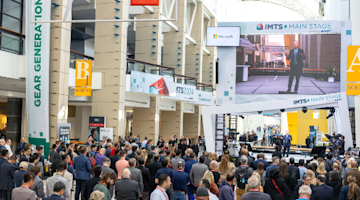This is part 2 of AMT’s sustainable manufacturing article series and follows part 1, “Sustainable Requires Ingenuity and Stewardship.”
When industry talks about improving sustainability in manufacturing, water is last on the priority list. In many places around the United States, water is plentiful, available, and inexpensive. Reducing water usage lacks the same urgency as other conservation measures that also offer significant cost savings, such as reducing energy use.
However, conserving water will likely become more important for multiple reasons:
Fresh water resources are becoming increasingly scarce, especially in the Southwest.
Utility costs will increase as water becomes more scarce.
Regulation compliance will become more onerous in water-sensitive regions.
Conserving resources and reducing environmental impact in their communities is a win for manufacturers.
Hidden costs
The cost of purchasing water from a utility may not seem significant enough alone to merit a reduction in water use, but it becomes a bigger expense when adding the associated costs for processing, using, and discharging water. These costs may include wastewater treatment equipment and chemicals, energy use for pumping, disposal fees, third-party treatment services, and dedicated labor. Plus, facilities in water-stressed areas may experience disruptions in water supply, which can slow down or stop a production line.
The U.S. Environmental Protection Agency (EPA), has a to help manufacturers calculate the costs associated with water use at their facilities.
Measuring water use
The first step in understanding a facility’s water use is measuring it. The old-school way to measure water consumption has involved a person with a clipboard walking around the facility collecting information from meters and putting it into a spreadsheet — where it often sits underutilized. , a water management provider in Bellingham, Washington, offers a more efficient solution:real-time water measurement and analytics that identify sources of water waste throughout a facility.
Manufacturers use water for many purposes, such as cleaning, cooling, lubrication in CNC machining, and facilitating some finishing processes such as deburring. Companies also use water for landscape irrigation, facility temperature control, bathrooms, and food service.
Apana strategically places high-resolution water meters throughout a facility to monitor water use in real-time and then sends that data via a secure internet to a cloud-based analytics engine. The system not only tracks water use but looks for abnormal patterns during certain times of day and other anomalies over time. In the event of an issue, the system alertsoperators, plant managers, and maintenance managers. Apana then providesactionable guidance on how to fix the problem.
“The information we provide helps the front line, but it also helps the C-suite to prioritize projects that reduce water use going forward. We deliver quantifiable results on the company’s investments in water use improvements,” says , Apana CEO and company founder. “Our customers view us as a business efficiency tool that also provides a sustainability impact.”
Apana started out serving water-hungry facilities for large retail chains, food processors, vineyards, and even the Belagio Casino in Las Vegas (home of the ). Seeing an increasing demand for services from manufacturers, Apana has expanded into water management at manufacturing facilities.
“There’s a huge opportunity to reduce water use for manufacturers processing a lot of sheet metal, such as in the appliance and automotive sectors,” Rose adds. “For example, on average, it takes several hundred gallons of water to manufacture an automobile.”
Machining with less water
By adopting new machining technology that requires less water than traditional methods, manufacturers can reduce water consumption.
, a provider of metal cutting solutions, has been rapidly expanding its for dynamic machining that need little or no water for lubrication and chip removal in certain material types. Seco engineers specific flute shapes and adds state-of-the-art coatings so the tools generate less heat. To further reduce water use, the geometry of the tools promotes good chip evacuation.
While the company’s technology was born out of a demand for higher throughput and longer tool life, the reduction in water-based coolant is a beneficial byproduct.
“We can machine 4140, pH hardened stainless steel, and other mild to hardened tool steels completely dry now,” says , product manager-solid milling at Seco. “It’s especially important to eliminate water-based coolants for milling medical-grade titanium parts because it prevents sterilization concerns. We are currently working with technology partners to develop dry machining solutions for this industry segment, but using water-based and oil-based coolants is still the industry standard for the time being.”
Following its success with tool steels, Seco is currently developing dry milling tools for machining aluminum aerospace components.
Reusing water
Cleaning and reusing water whenever possible is another strategy. , maker of solutions for centrifuge and membrane filtration, offers the for wastewater reuse in manufacturing facilities. The ultrafiltration membrane technology separates water and dissolved chemicals from suspended solids and emulsified oils, which enables water reuse. The system can process up to 1,500 gallons per day of metalworking coolants, parts washing solutions, deburring wastes, mop water, and paint wash water.
“Compared to the cost companies paying to dispose of their wastewater, most users of our ultrafiltration systems see a return on investment in two years,” says Jon Guinn, sales manager at Sanborn. “We're reducing the volume of their wastewater by 95% in most applications.”
By committing to better water efficiency, the manufacturing industry can reduce costs, avert potential scarcity risks, and be good stewards of the resources in their communities. While pressures to change are not great right now, water sensitivity could become more problematic. To tackle water use before it becomes problematic, the program provides best practices for facilities to start their own water management initiatives.
Read more about what sustainable manufacturing means and why it matters. Part 3 of our Sustainable Manufacturing article series will address considerations for using more sustainable materials in manufacturing. Part 1, “Sustainable Requires Ingenuity and Stewardship” reviews theforces driving more sustainable manufacturing practices.









